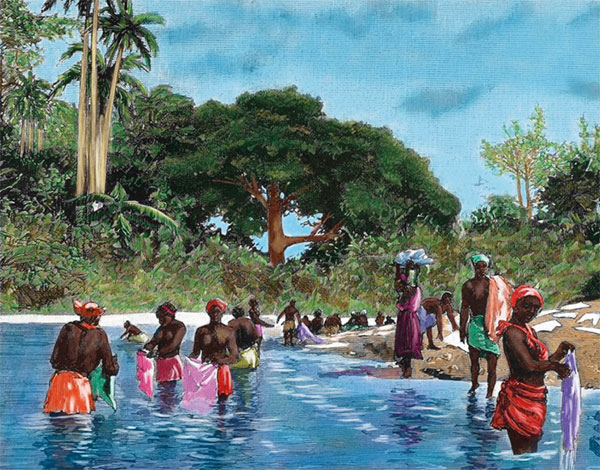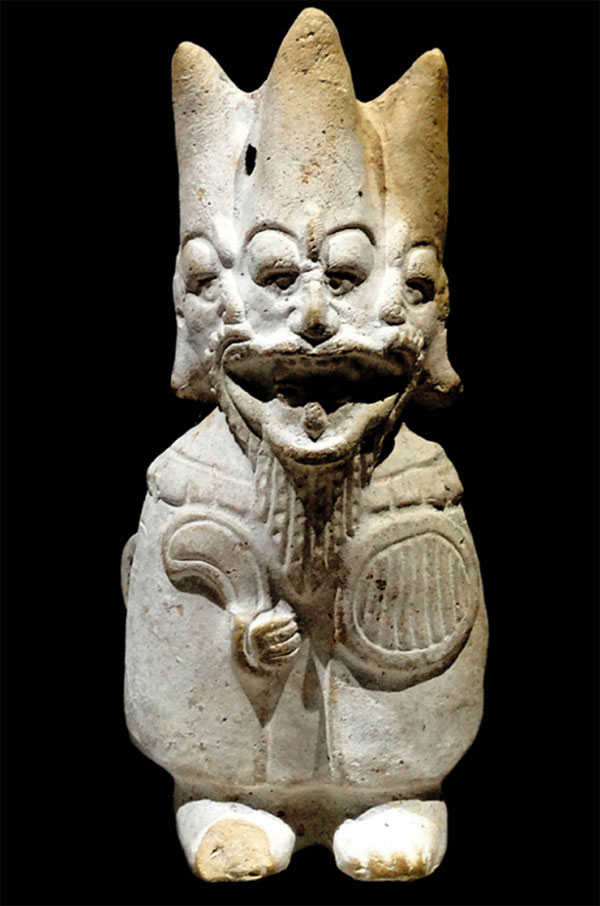Decisive dates

An engraving of washerwomen on the river Chagres at Matachin, Panama, from 1879.
The pre-Hispanic era
c.10,000 BC
Earliest animal remains: mammoth bones found at Loltún in Yucatán.
c.6000–2000 BC
Early settlers farm maize and beans, make pottery, and probably speak a Proto-Maya language.
c.2000 BC
First evidence of fixed Maya settlements at Nakbé, Cuello, Loltún, Mani, and along the Pacific coast at Ocos.
500 BC
Period of first monumental buildings at sites such as Tikal. Influence of the Olmec culture.
100 BC
El Mirador established as the first Maya ‘superpower’; 70-meter (230ft) temples are completed, and fabulous murals of San Bartolo painted.
c.AD 1
Emergence of Teotihuacán in Mexico.
AD 150
Collapse of Preclassic cities, including El Mirador, probably due to environmental breakdown.
250–450
Maya region and much of Mexico influenced, or even dominated, by Teotihuacán.
300
Start of Classic period. First stelae found with exact date in central region: Stela 29 at Tikal, dated AD 292.
426
Yax K’uk Mo’ (probably from Teotihuacán) founds dynasty at Copán.
550–695
Rival ‘superpowers’ Tikal and Calakmul fight for dominance in the central region. In AD 695 Tikal avenges a bitter earlier defeat by overrunning Calakmul, and the city never recovers its former glory.
700–800
Peak of Maya Classic period, all through the region: sites such as Uxmal, Kabah, and Chichén Itzá at their height in Yucatán, Palenque in Chiapas. Population in central region reaches an estimated 10 million by 750.
800–900
Decline of Classic Maya sites, possibly due to overpopulation and drought, leading to environmental collapse. The last recorded inscription at Palenque is from AD 799; at Tikal it is AD 869.
1000
Postclassic period, with the emergence of fortified sites in Yucatán region and several competing groups in Guatemala.
1250
The fall of Chichén Itzá and emergence of Mayapán as center of influence in Yucatán. In Guatemala the K’iche’, Kaqchikel, and Mam tribes dominate region. Tulum emerges as important trading center.
1440
Decline of Mayapán, and breakup of Maya groups in Yucatán into small areas of influence.
The Spanish conquest
1519
Hernán Cortés arrives on island of Cozumel off Yucatán at the start of the discovery and conquest of Mexico; the first Mass on the American continent is held.
1523
Spanish exploration and conquest of Guatemala under Pedro de Alvarado, who defeats the K’iche’.
The colonial era
1527
First Spanish capital of Guatemala founded. Francisco de Montejo begins his conquest of Yucatán.
1541
Capital of Guatemala is moved to Antigua.
1542
Foundation of Mérida, which becomes the Spanish capital of Yucatán.
1540s
Franciscan friars set out to bring Christianity to Maya.
1600s
First ‘Baymen’ begin to settle near mouth of Belize River, and exploit forests of the region and trade in logwood for dyes.
1638–40
Maya rebellion drives Spanish out of Belize.
1671
Pirate Henry Morgan captures Panama.
1697
Last Maya stronghold in Guatemala falls with conquest of the Itzá on a Lake Petén Itzá island.
1739
First of the Maya manuscripts rediscovered in Vienna and taken to the German city of Dresden, to become known as the Dresden Codex.
1746
Father Antonio de Solis is first European to discover the site of Palenque in Chiapas, Mexico.
1765
A set of regulations, ‘Burnaby’s Code,’ drawn up as first constitution for what becomes British Honduras (Belize).
1786
Spanish captain Antonio del Río explores Palenque for Spanish king.
Independence movements
1798
The Battle of St George’s Caye between British and Spanish naval forces. Defeat of Spanish fleet firmly establishes British rule of Belize region.
1821
Mexico and Central America win independence from Spain. Guatemala, Honduras, Nicaragua, and El Salvador form Central American Federation. Yucatán and Chiapas also join federation, but then join Mexico in 1823. The Garífuna establish first settlement in Dangriga, Belize.
1823
San José replaces Cartago as the capital in Costa Rica.
1838
Central American Federation splits. Guatemala, El Salvador, Honduras, Nicaragua, and Costa Rica become independent.
1841
Incidents of Travel in Central America, Chiapas and Yucatán by the explorer John Lloyd Stephens, illustrated by Frederick Catherwood, begins the era of scientific investigation of the great Maya sites. Maya of Yucatán declare independence from Mexico. A republic is declared, which lasts until 1848.
1847
Guatemala becomes an independent republic. War of the Castes erupts in Yucatán, a Maya revolt that simmers for more than 50 years.
1848
Declaration of the Republic of Costa Rica.
1854
Earthquake destroys San Salvador, El Salvador.
1856
American adventurer William Walker becomes president of Nicaragua.
1857
The Popol Vuh, the sacred book of the K’iche’ Maya, is published in a French translation.
1858
Costa Rica defeats William Walker, who sought to turn Central America into a colony of the southern American states.
1859
Convention between the UK and Guatemala recognizes the boundaries of British Honduras, but these are subsequently disputed by Guatemala.
1862
British Honduras becomes an official British colony.
The modern era
1893
Mexico renounces its longstanding claim to territory of British Honduras and signs a peace treaty. Guatemala still claims sovereignty.
1903
The United States is granted exclusive control of a 16km (10-mile) corridor across Panama.
1910
Mexican revolution led by Francisco Madero against Porfirio Díaz. An earthquake destroys Cartago, Costa Rica, killing 700.
1914
The Panama Canal is completed.
1923
Yucatán governed by revolutionary socialists.
1924
Yucatán’s Socialist leader, Governor Felipe Carrillo Puerto, assassinated during a failed military revolt.
1931
Dictator Jorge Ubico president in Guatemala: banana boom led by United Fruit Company. Belize City destroyed by hurricane.
1932
30,000 killed during peasant uprising in El Salvador.
1939
As coffee exports stagnate, Costa Rica declares war on Germany, Japan, and Italy.
1944–54
Progressive nationalist governments in Guatemala under presidents Arévalo and Jácobo Arbenz. Land reform and attempts to curb power of US-owned banana companies.
1948
Civil War erupts in Costa Rica, and a junta led by José Figueres takes over. Under the new constitution, the army is disbanded.
1954
Che Guevara arrives in Guatemala City. A CIA-backed coup in Guatemala leads to the overthrow of Arbenz, start of military rule, and civil war.
1970s
Oil is discovered off the Campeche coast and Cancún is developed for mass tourism.
1973
British Honduras is renamed Belize.
1976
Earthquake in Guatemala leaves 23,000 dead.
1979
The Sandinistas in Nicaragua topple the Somoza dictatorship; civil war ensues. Over 30,000 killed in El Salvador by government-sponsored death squads.
1981
Belize gains independence from the UK.
1982
Guatemalan guerrillas form Guatemalan National Revolutionary Unity (URNG). US funded attacks by Contra rebels based in Honduras begin in Nicaragua.
1986
Guatemala returns to civilian government. Costa Rican president Oscar Arias Sánchez helps restore peace to the region and is later awarded the Nobel Peace Prize.
1988
US charges Panamanian president Manuel Noriega with drug smuggling; following year US invades Panama and ousts Noriega.
1991
Guatemala recognizes self-determination of the people of Belize in return for Caribbean coastal waters.
1992
Rigoberta Menchú is awarded the Nobel Prize for Peace.
1994
On 1 January, Mexico joins the North American Free Trade Agreement with the US and Canada. The same day, Lacandón Maya Indians and the Zapatista National Liberation Army rebel in Chiapas.
1996
Final peace accords signed in Guatemala end more than 30 years of civil war in which about 200,000, mostly Maya, were killed or disappeared.
1998
Hurricane Mitch sweeps Central America.
1999
US transfers control of the Panama Canal to Panama.
2004
Military numbers and budget cut in Guatemala; CAFTA trade agreement approved; Panama Canal earns a record $1 billion in revenue.
2005
Hurricane Wilma wreaks havoc in Mexico’s Yucatán Peninsula; several people are killed.
2009
Honduran President Jose Manuel Zelaya is overthrown by the military.
2010
Laura Chinchilla (PLN) becomes the first female president of Costa Rica.
2012
Festivities planned across the Maya world to mark the end of a Great Cycle in the Maya calendar on 21 December.
2013
Chinese billionaire Wang Jing is granted a 50-year concession to build and operate a canal across Nicaragua.
2015
Chinese stock market crash puts plans for Nicaragua’s Grand Interoceanic Canal on hold. Costa Rica’s Turrialba volcano erupts, spewing a column of ash 2,500 meters (8,202ft) high.
2016
The Panama Canal finishes a nine-year, $5.4 billion expansion that more than doubles its capacity. The Nicaraguan government frees 8,000 prisoners in an effort to ease overcrowding in Nicaragua’s jails.
2017
Costa Rica sues Nicaragua over the military camp at Isla Portillos on Costa Rican territory.
2019
Guatemala and the USA sign a migration agreement that means migrants heading to the US and passing through El Salvador and Honduras beforehand must seek asylum in Guatemala first.
2023
Anti-corruption campaigner, Bernardo Arévalo wins presidential election in Guatemala with 58 percent majority, marking a new, more democratic era for the country.

Mayan ceramic figurine of a Lord, circa 600–900 AD, Mexico.